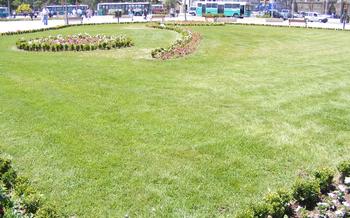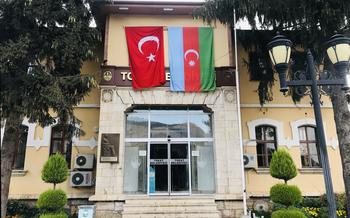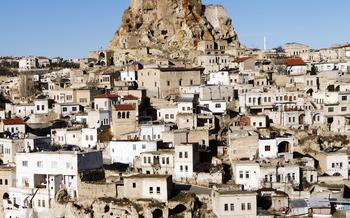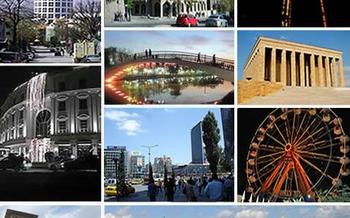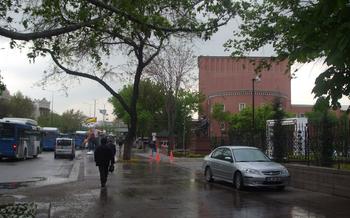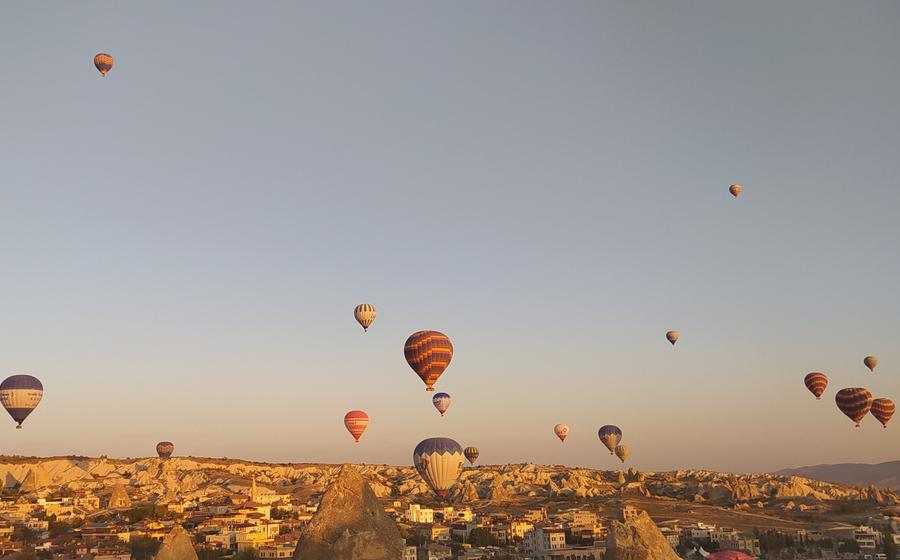
Mazi Underground City
- Historical Background
- Architecture and Layout
- Historical Significance
- Exploration and Discovery
- Things to See and Do
- Explore the depths of the Mazi Underground City
- Immerse yourself in history and culture
- Uncover hidden secrets and legends
- Tips for maximizing your visit
- Guided Tours
- Self-Guided Exploration
- Accessibility:
- Photography and Videography
- Local Cuisine
- Accommodations
- Souvenirs and Shopping
- Safety Tips
- Insider Tip: Unveiling the Hidden Treasures of the Mazi Underground City
Historical Background
The Mazi Underground City, nestled in the heart of Nevşehir, Turkey, stands as a testament to the ingenuity and resilience of ancient civilizations. Its origins can be traced back to the 3rd century BC, during the reign of the Hittites, who carved out a labyrinthine network of tunnels and chambers to serve as a refuge from invading armies and periods of unrest. Over the centuries, the city was expanded and modified by successive civilizations, including the Romans, Byzantines, and Seljuks, each leaving their unique mark on its architecture and design.
The Mazi Underground City is a remarkable feat of engineering, showcasing the advanced construction techniques and architectural prowess of ancient builders. Its intricate ventilation systems, water wells, and living quarters demonstrate a deep understanding of sustainability and self-sufficiency. The city's strategic location, hidden beneath the earth's surface, provided a safe haven for local communities during times of turmoil, allowing them to retreat underground and escape the ravages of war and persecution.
The rediscovery of the Mazi Underground City in the 1960s sparked a wave of excitement and fascination among archaeologists and historians. Subsequent excavations revealed a vast and complex network of tunnels, rooms, and chambers, shedding light on the remarkable resilience and resourcefulness of ancient civilizations. Today, the city stands as a living testament to the rich history and cultural heritage of Turkey, attracting visitors from around the world who come to marvel at its architectural wonders and experience a glimpse into the lives of those who sought refuge within its hidden depths.
Architecture and Layout
The Mazi Underground City showcases remarkable architectural ingenuity and engineering prowess. Constructed over several levels, the city features a complex layout with interconnected tunnels, rooms, and chambers. The tunnels, varying in height and width, often lead to different sections of the city, creating a maze-like structure.
The city's construction involved a combination of natural and man-made materials. The primary material used was volcanic tuff, a soft and porous rock that allowed for easy excavation and carving. The city's builders skillfully utilized the natural properties of the tuff to create a stable and durable underground structure.
Unique features of the city include ventilation systems that ensured a constant supply of fresh air throughout the complex. These systems consisted of cleverly designed air shafts and chimneys that channeled air from the surface down into the underground chambers. Water wells, strategically placed within the city, provided a reliable water source for the inhabitants.
Living quarters, storage rooms, stables, and communal areas were meticulously planned and constructed within the underground complex. The living quarters, often small and simple, accommodated families and individuals seeking refuge in times of danger. Storage rooms were used to store food, supplies, and other essential items. Stables housed animals that provided transportation and sustenance. Communal areas served as gathering spaces for social interaction and community activities.
The Mazi Underground City stands as a testament to the creativity, resourcefulness, and engineering skills of its ancient builders. Its well-thought-out design and construction techniques allowed the city to serve as a safe haven for thousands of people during times of turmoil and instability.
Historical Significance
The Mazi Underground City stands as a testament to the ingenuity and resilience of ancient civilizations. Built as a refuge during times of invasion and unrest, it provided shelter and protection to local communities for centuries. Its strategic location and well-thought-out design allowed the city's inhabitants to remain hidden and safe from external threats.
Legend has it that the city was once home to a thriving Christian community seeking refuge from religious persecution during the Byzantine era. The underground tunnels and chambers provided a safe haven for these early Christians, who could practice their faith in secret.
Stories abound about the city's role in protecting the local population from invading armies. During the Mongol invasion of the 13th century, the city's inhabitants successfully repelled the attackers by using cunning tactics and memanfaatkan the city's hidden location.
The historical significance of the Mazi Underground City extends beyond its role as a refuge. It offers valuable insights into the architectural prowess and engineering skills of ancient civilizations. Its intricate ventilation systems, water wells, and living quarters demonstrate a sophisticated understanding of urban planning and resource management.
Exploring the Mazi Underground City is a journey through time, allowing visitors to experience firsthand the resilience and creativity of our ancestors. It is a reminder of the power of human ingenuity and the importance of preserving our cultural heritage.
Exploration and Discovery
The rediscovery of the Mazi Underground City is a fascinating tale of perseverance and serendipity. In the 1960s, a local farmer named Mustafa Aksoy stumbled upon a mysterious entrance while digging a well on his property. Intrigued, he decided to explore further, leading to the gradual uncovering of the vast underground complex. The excavation process was painstaking and challenging, as the city had been buried for centuries under layers of earth and debris. Archaeologists and researchers worked tirelessly to clear the tunnels, rooms, and chambers, revealing the intricate layout and remarkable preservation of the city.
The discovery of the Mazi Underground City was a significant archaeological breakthrough, shedding new light on the history and culture of ancient civilizations in Turkey. It provided valuable insights into the ingenuity and resourcefulness of the people who built and inhabited the city. The excavation also uncovered a wealth of artifacts, including pottery, tools, and religious objects, which helped to piece together the story of the city's past. Today, the Mazi Underground City stands as a testament to the enduring legacy of ancient Anatolian civilizations, attracting visitors from around the world who are eager to explore its hidden depths and uncover its secrets.
Things to See and Do
Explore the depths of the Mazi Underground City
Discover the fascinating world beneath the surface of Nevşehir as you explore the Mazi Underground City. Wander through the intricate network of tunnels, chambers, and rooms that once served as a refuge for local communities. Marvel at the ingenuity and craftsmanship of the ancient builders as you navigate through the well-preserved structures.
Immerse yourself in history and culture
Step back in time as you explore the various attractions and activities available at the Mazi Underground City. Learn about the city's rich history and significance through interactive exhibits and educational programs. Experience the unique atmosphere of the underground chambers, where you can imagine the lives of those who sought shelter within these walls.
Uncover hidden secrets and legends
As you explore the Mazi Underground City, keep an ear out for the local legends and stories that surround this mysterious place. Discover the tales of brave warriors, hidden treasures, and supernatural encounters that have been passed down through generations. Each story adds to the allure and mystique of this ancient city, making your visit even more memorable.
Tips for maximizing your visit
To make the most of your experience at the Mazi Underground City, consider the following tips:
- Wear comfortable shoes and clothing, as you'll be doing a lot of walking and climbing.
- Bring a flashlight or headlamp, as some areas of the city may be dimly lit.
- Take your time to explore the different levels and sections of the city, as there's much to discover.
- If you're interested in learning more about the city's history, consider booking a guided tour.
Guided Tours
Exploring the Mazi Underground City with a guided tour is an enriching experience that offers historical insights and storytelling. Knowledgeable guides bring the city's past to life, sharing fascinating tales and anecdotes about its construction, its role in ancient civilizations, and the lives of its inhabitants. These tours typically cover the various levels, rooms, and chambers of the city, explaining their functions and significance. Visitors can ask questions and engage in discussions, gaining a deeper understanding of the underground city's history and cultural importance. Guided tours are available in multiple languages, ensuring accessibility for international visitors. Booking a tour in advance is recommended, especially during peak tourist seasons, to secure a spot and avoid disappointment.
Self-Guided Exploration
The Mazi Underground City offers the option of self-guided exploration for visitors who prefer to discover the site at their own pace. A detailed map or guidebook is available to help you navigate the underground complex independently. Exploring on your own allows you to set your own itinerary and spend as much time as you like in each area. You can pause to take photos, read the informative signs, and soak in the unique atmosphere of the city.
However, self-guided exploration also comes with its challenges. Without a guide to provide historical context and explanations, you may miss out on important details or fail to fully appreciate the significance of what you're seeing. Additionally, some areas of the city may be closed off or require special permission to access.
To make the most of your self-guided visit, come prepared with a map, flashlight, and comfortable shoes. Be sure to read the information signs carefully and take your time exploring the different levels and chambers. If you have any questions or encounter any difficulties, don't hesitate to ask for assistance from the friendly staff at the visitor center.
Accessibility:
The Mazi Underground City is committed to ensuring accessibility for visitors with disabilities. Wheelchair users and people with limited mobility can easily explore the site with the help of accessible entrances, ramps, and elevators. The city's main attractions, including the tunnels, rooms, and chambers, are designed to accommodate visitors of all abilities. Visitors with disabilities are encouraged to contact the site's administration in advance to arrange for any specific assistance or accommodations they may require. The Mazi Underground City strives to create an inclusive and welcoming environment for all visitors, ensuring that everyone can experience the wonders of this ancient underground marvel.
Photography and Videography
The Mazi Underground City is a treasure trove for photographers and videographers, offering unique opportunities to capture the essence of this ancient marvel. While photography and videography are generally allowed within the site, there are a few guidelines to keep in mind.
-
Respect the Privacy of Others: Avoid taking photos or videos of other visitors without their consent, especially in private areas like living quarters or religious spaces.
-
Tripods and Flash Photography: The use of tripods and flash photography is generally not permitted within the underground city. These devices can disrupt the delicate environment and affect the visibility of other visitors.
-
Professional Photography and Videography: If you're a professional photographer or videographer looking to capture the Mazi Underground City for commercial purposes, you may need to obtain special permission or a permit from the local authorities.
-
Capturing the Best Shots: To capture stunning images, consider using a wide-angle lens to capture the vastness of the underground chambers. Experiment with different angles and perspectives to create unique and compelling shots. For videographers, consider using a stabilizer or tripod to ensure smooth and steady footage.
-
Preserve the Heritage: Remember that the Mazi Underground City is a historical site, and it's important to respect and preserve its heritage. Avoid touching or damaging any artifacts or structures, and always follow the guidelines provided by the site's management.
Local Cuisine
The Nevşehir region boasts a rich culinary tradition that reflects the cultural influences of various civilizations that have shaped its history. Visitors to the Mazi Underground City can indulge in a diverse range of traditional dishes that showcase the region's unique flavors and ingredients.
One must-try dish is the famous "Testi Kebabı," a slow-cooked lamb stew prepared in a sealed clay pot. The tender meat and flavorful broth, infused with spices and vegetables, create a mouthwatering experience. Another local delicacy is "Gül Göremesi," a sweet pastry filled with pistachios and walnuts, symbolizing the region's rich agricultural heritage.
For a taste of authentic Turkish cuisine, visitors can head to the local restaurants near the Mazi Underground City. These eateries offer a warm and welcoming atmosphere, allowing visitors to immerse themselves in the local culture while savoring delicious dishes.
Supporting local businesses is crucial for preserving the region's culinary traditions. By choosing to dine at local restaurants and cafes, visitors not only enjoy authentic flavors but also contribute to the sustainability of the local economy.
One personal recommendation is the "Karacaören Restaurant," located just a short walk from the underground city. This family-run establishment serves traditional Turkish dishes prepared with fresh, locally sourced ingredients. Their "Manta," a type of Turkish ravioli filled with ground lamb and spices, is a must-try for those seeking a culinary adventure.
Accommodations
When planning your trip to the Mazi Underground City, finding suitable accommodations is essential. The city is located near the town of Nevşehir, which offers a range of accommodation options to suit different budgets and preferences.
For a luxurious and comfortable stay, consider booking a room at one of the upscale hotels in Nevşehir. These hotels often feature modern amenities, spacious rooms, and stunning views of the surrounding landscape.
If you prefer a more budget-friendly option, several guesthouses and hostels are available within walking distance of the underground city. These accommodations offer basic amenities and a cozy atmosphere, allowing you to mingle with other travelers and share experiences.
For a truly immersive experience, consider staying in a traditional Turkish homestay. This option allows you to live with a local family and experience their daily life and customs. Homestays often offer delicious home-cooked meals and provide a unique opportunity to learn about Turkish culture and traditions.
When choosing your accommodation, consider factors such as your budget, desired level of comfort, and proximity to the underground city. Booking your stay in advance is recommended, especially during peak tourist season, to secure the best rates and availability.
Souvenirs and Shopping
After exploring the depths of the Mazi Underground City, take some time to browse the local shops and markets for unique souvenirs to remember your visit. Support local artisans by purchasing handmade crafts, such as intricate pottery, colorful textiles, and traditional Turkish carpets. Discover one-of-a-kind jewelry pieces inspired by the region's rich history and culture. Savor the flavors of local delicacies like Turkish delight, baklava, and apple tea, perfect for sharing with friends and family back home. Remember, your purchases not only serve as mementos but also contribute to preserving the vibrant traditions of Nevşehir.
Safety Tips
Exploring the Mazi Underground City requires visitors to take certain safety precautions. First and foremost, comfortable and sturdy shoes are a must for navigating the uneven terrain and stairs within the city. Visitors should also consider bringing a flashlight or headlamp, as some areas may be dimly lit. Additionally, it is advisable to stay hydrated, especially during hot weather, as the underground environment can be quite warm and humid.
For those with claustrophobia or a fear of confined spaces, it is important to assess their comfort level before entering the underground city. The tunnels and chambers can be narrow and low-ceilinged in places, and visitors may feel a sense of enclosure. It is advisable to proceed slowly and take breaks as needed if feeling overwhelmed.
Finally, visitors should be aware of the potential for slippery surfaces, especially after rain or snowfall. Caution is advised when walking on wet or icy steps or floors to avoid accidents. By following these simple safety tips, visitors can ensure a safe and enjoyable experience exploring the Mazi Underground City.
Insider Tip: Unveiling the Hidden Treasures of the Mazi Underground City
Beyond the well-trodden paths of the Mazi Underground City, a hidden treasure awaits those willing to venture off the beaten track. Nestled deep within the labyrinthine tunnels, discover a secret chamber adorned with intricate carvings and ancient inscriptions. This hidden gem, known only to a select few, offers a glimpse into the city's rich history and the lives of its former inhabitants.
To find this secret chamber, follow the main tunnel until you reach a junction. Turn left and proceed cautiously through a narrow passageway. As you approach the end of the passage, look to your right for a concealed entrance hidden behind a large rock. Enter this chamber with reverence, for you are now standing in a place untouched by time.
The walls of the chamber are adorned with exquisite carvings depicting scenes from daily life in the underground city. Farmers tending their crops, merchants trading goods, and families gathered around a hearth are just some of the vignettes immortalized in stone. Ancient inscriptions in a forgotten language provide tantalizing clues about the city's past, waiting to be deciphered by curious minds.
As you stand in this hidden chamber, surrounded by the echoes of centuries past, you cannot help but feel a sense of awe and wonder. This secret place, preserved in darkness for generations, offers a unique perspective on the resilience and ingenuity of the people who once called the Mazi Underground City home.

